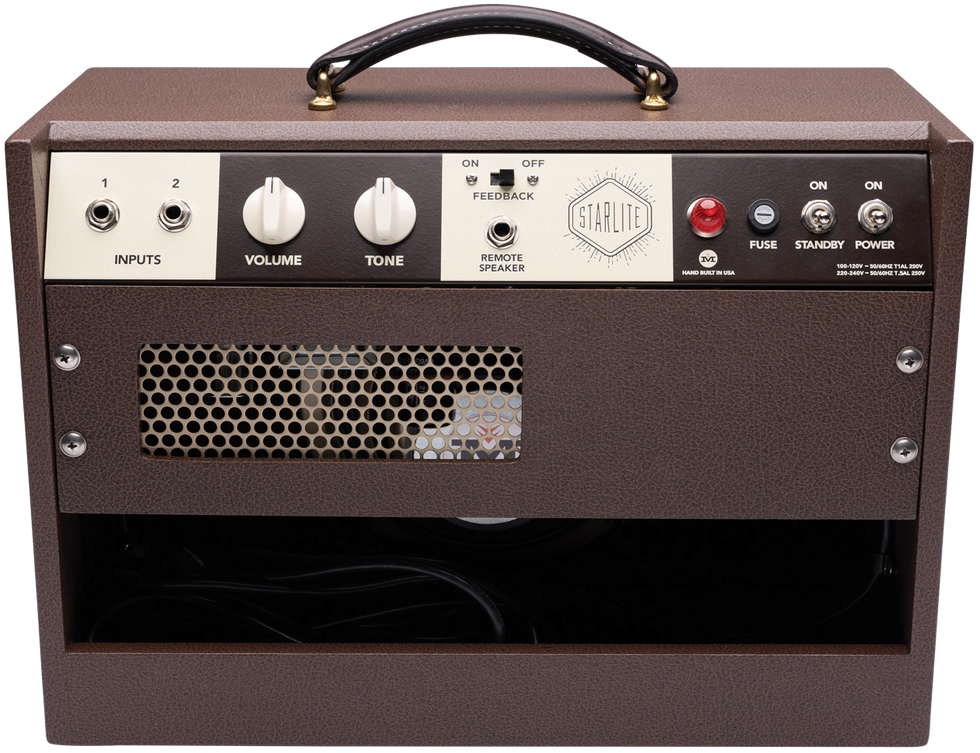The fact that small amps excel—and can sound really big—in studio situations isn’t news as much as it’s audio engineering gospel. But while little amps like the Fender Champ, Gibson Skylark, and Danelectro DM10 have been pulling feats of trompe-l’oeil on records for decades, some small combos still sound bigger and badder than others. And I feel pretty good about making the case for Magnatone’s new 5-watt Starlite as one of the biggest sounding—and most flexible—little amps that’s ever joined this club of overachievers.
Maggie Mélange
The Starlite is something of an early-’60s Magnatone mashup. The name is borrowed from a series of Maggies from the mid ’60s best known for their arresting “squiggle” grill cloth. But the cabinet design and circuit are more closely related to the Custom 210, a 5-watt, single-6V6GT-powered rival to the Fender Champ and other small amps of the time, distinguished by the inclusion of Magnatone’s rather legendary vibrato circuit.
Sadly, there’s no vibrato on the new Starlite. The inclusion of the effect would have likely made the amp exceedingly expensive for its size. But the flexibility of the Starlite’s circuit is still extra impressive thanks to a clever tone control and a negative feedback switch that, as we will see, can profoundly transform the sound and tactile experience of playing the Starlite.
Just like every new Magnatone we’ve seen since the company’s 2014 resurrection, the Starlite is both sturdy and exceedingly handsome. I can’t think of an amp that’s less likely to disrupt the design of a well put-together living room. And its compact 17" x 8" x 12" dimensions might make it look—to less guitar-savvy interior-design-enthusiast friends—like a beautifully restored vintage radio or hi-fi speaker.

The Starlite’s construction is robust. Its smallest components, like caps and resistors—which number fewer than 30, by my count—are neatly arrayed on a glass epoxy PCB. The power transformer is from Hammond, and the power and preamp tubes are Apex-matched JJs—a 6V6S and 12AX7 respectively.
Tiny, Toneful, and Brutish
Though the benefits of using a small amp in a recording situation are well documented, there are limitations to such setups. Sometimes an 8-inch speaker won’t offer the bass response necessary for inciting a certain kind of performance. Lower wattage and smaller speakers can also change the way pedals like fuzz and high-gain overdrive respond to your playing in adverse ways. But if ever there were a 5-watt, 8-inch-speaker-equipped amp with the flexibility to help bridge those gaps, it’s the Starlite.
Much of the Starlite’s versatility is derived from its very flexible tone control. Magnatone suggests that it helps bridge tweed and black-panel Fender Champ sounds. And to some extent that is very true. Counter-clockwise from noon, the control scoops out progressively more midrange, which is a hallmark of black-panel Champs, resulting in exceptionally crisp, sparkling high-end output and honking, modest bass response with low to moderate amp distortion. Cranked to the gills, as any black-panel or early silver-panel Champ fan knows, this tone profile can sound pretty brash and splatty—particularly with single-coils. That’s where the midrange-boosted clockwise half of the tone control becomes invaluable.
Warmly saturated overtones can give you the confidence to lean hard on the amp at full volume without fear of being too piercing.
Clockwise from noon, the added midrange starts to massage and round off harsher transients while increasing saturation to the lows and low-mids, adding flattering contours to 5th- and 6th-string output and a satisfyingly distorted edge to high strings. Because of the Starlite’s class-A single-ended circuitry, there isn’t any of the tweed sag you associate with amps like the Deluxe—at least in the clinical sense. But these warmly saturated overtones can give you the confidence to lean hard on the amp at full volume without fear of being too piercing.
The beauty of both of these tone settings, and the many cool in-between shades available through the control’s ample range, is that the Starlite is super responsive to guitar-volume attenuation. You can very easily set the amp up at wide-open volume and move from aggressive crunchy tones to clean ones with a slight adjustment of your instrument’s controls.
The amp’s response and distortion makeup can also be completely reshaped by the negative feedback switch. With the switch on (a configuration that sets the amp up as Fender designers of old would have intended), the Starlite’s distortion tends to be warmer, and clean tones tend to be less spiky. In general, the negative feedback “on” settings were more satisfying and versatile to my ear. But in the moments I hankered for extra Mike Bloomfield-style sting, taking the negative feedback out of the mix was an enticing and thrilling option.
The Verdict
At $1,299, the Starlite is 100 bucks more than Fender’s excellent ’57 Custom Champ. And I suspect that for many potential customers, the more expansive and flexible tone control, negative feedback switch, output for an 8-ohm external, and the dashing, less-common styling will be worth the extra cash. Even if you find the head-to-head tweed-style comparisons a toss-up (and the Starlite is not, strictly speaking, a tweed Champ equivalent), the Maggie arguably has an edge in versatility. In its most black-panel-like settings, I still found the Starlite throatier, more massive, and even a little more sparkly on top than my otherwise sweetly ringing early-’70s silver-panel Champ (which is identical to a black-panel in most respects). The same qualities also make it a little more conducive to use of boost, overdrive, and fuzz, which, by the way, all sound fantastic-to-fantastically-trashy in tandem with the Maggie.
Such margins of advantage may be slim to modest in each comparison. But when using a small amp in the studio, where creating the illusion of a bigger amplifier is often the aim, the Starlite’s knack for lending a little extra illusion of mass and muscle is no small consideration.











![Devon Eisenbarger [Katy Perry] Rig Rundown](https://www.premierguitar.com/media-library/youtube.jpg?id=61774583&width=1245&height=700&quality=70&coordinates=0%2C0%2C0%2C0)
















